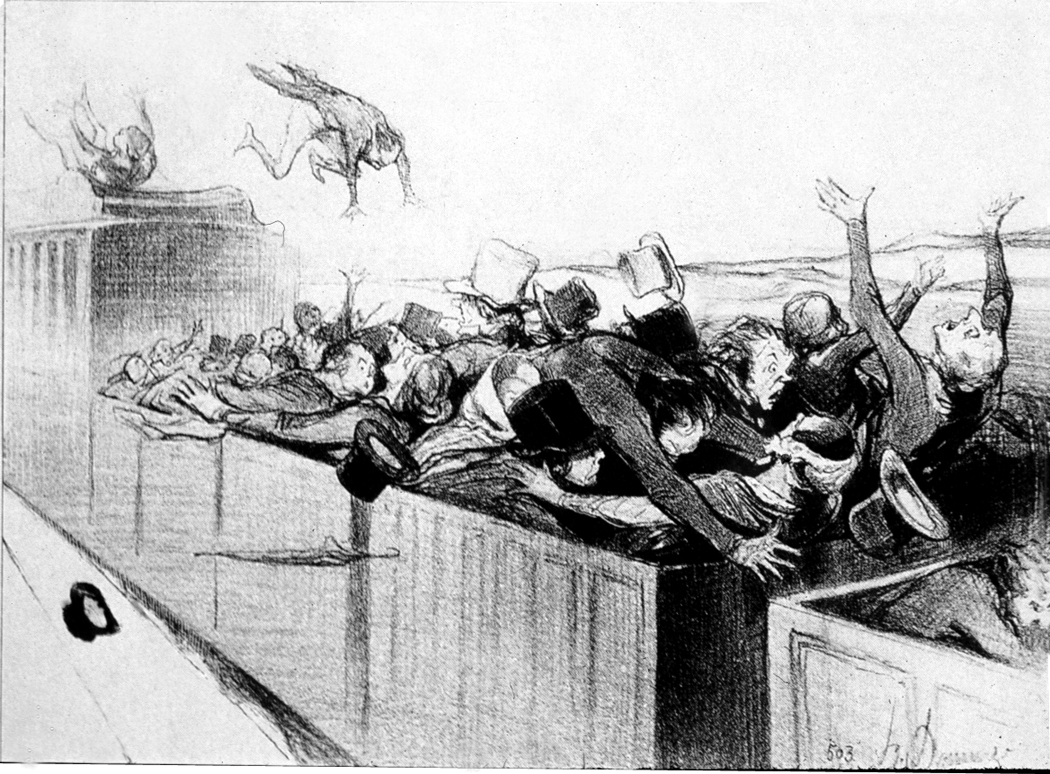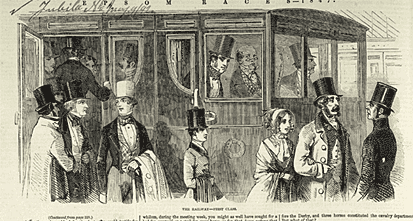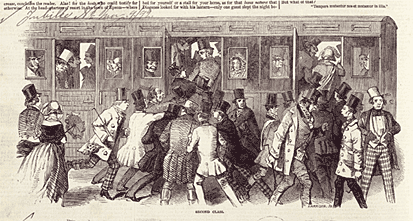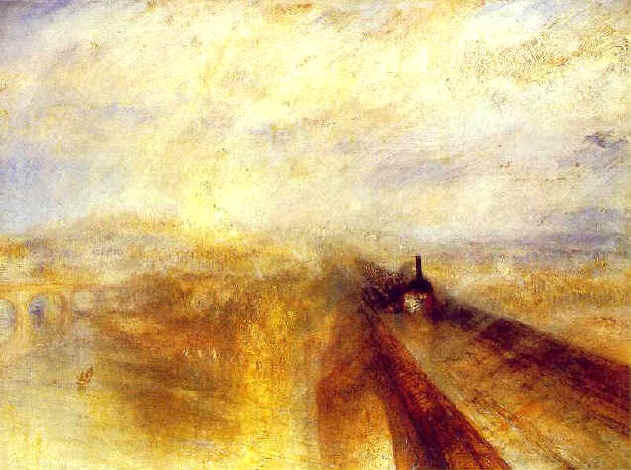Miscellaneous and Picture Gallery
Pictures and text (if not self-explanatory) to be added as time allows (if ever!). For more images, see the various subdirectories of this site.
Caveat: This site may take time to download---pictures!
Railroad and Class
Issues of class are of course evident everywhere in the cultural history of railroading. For that reason, I have not created a specific subdirectory---it would simply be too comprehensive and without definition. However, below I have assembled some poignant references that point to the issues of class and social division surrounding this new transport technology from its very inception. The references do not account for the differences between British and American railroading. Please see the passages, sketches, and pictures on other parts of this site for additional references.
- High above the grim and grimy crowd of scowling faces a loom had been erected, at which sat a tattered, starved-looking weaver, evidently set there as a representative man, to protest against the triumph of machinery and the gain and glory which the wealthy Liverpool and Manchester men were likely to derive from it.
- Fanny Kemble, actress, opening of the Liverpool and Manchester Railway, 1830 - The traveller by railway is made aware of his approach to the great northern seats of industry by the dull leaden-coloured sky, tainted by thousands of ever smoking chimneys, which broods over the distance. The stations along the line are more closely planted, showing that the country is more and more thickly peopled. Then, small manufacturing villages begin to appear, each consisting of two or three irregular streets clustered around the mill, as in former times cottages were clustered round the castle.
You shoot by town after town - the outlying satellites of the great cotton metropolis. They have all similar features - they are all little Manchesters. Huge, shapeless, unsightly mills, with their countless rows of windows, their towering shafts, their jets of waste steam continually puffing in panting gushes from the brown grimy wall. Some dozen or so of miles so characterised, you enter the Queen of the cotton cities - and then amid smoke and noise, and the hum of never ceasing toil, you are borne over the roofs to the terminus platform. You stand in Manchester.
There is a smoky brown sky over head - smoky brown streets all round long piles of warehouses, many of them with pillared and stately fronts - great grimy mills, the leviathans of ugly architecture, with their smoke-pouring shafts. There are streets of all kinds - some with glittering shops and vast hotels, others grim and little frequented - formed of rows and stacks of warehouses; many mean and distressingly monotonous visas of uniform brick houses.
There are swarms of mechanics and artisans in their distinguishing fustian - of factory operatives, in general undersized, sallow-looking men - and of factory girls somewhat stunted and paled, but smart and active-looking with dingy dresses and dark shawls, speckled with flakes of cotton wool, wreathed round their heads.
- Angus, Reach, The Morning Chronicle, 1848 - Millions of men and women died in their own towns and villages without ever having travelled five miles from the spot where they were born. How vividly I remember my first long journey away from Oldham. I had to attend a conference of the Gasworkers Union at Plymouth. To get there entailed a railway journey down the length of England.
Men of my own class were driving the engine and acting as porters. I remember a sensation of power as I glimpsed a future in which all these men would be teamed up together with mill-hands, seamen, gas-workers - in fact, Labour everywhere - for the benefit of our own people.
The least change of accent in speech, as we stopped at various towns, fascinated me, and I noted varieties of face, dress and manner. That was a wonderful journey for me, who had never before been out of the Lancashire murk. To look through the carriage windows and see grass and bushes that were really green instead of olive, trees that reached confidently up to the sun instead of our stunted things, houses that were mellow red and white and yellow, with warm red roofs, instead of the Lancashire soot and slates, and stretches of landscape in which the eye could not find a single factory chimney belching - this was sheer magic!
I began to experience an inexhaustible wonder at the gracious beauties of the world outside factory-land, and this sensation has never wholly left me. That first long railway journey was as wonderful to me as if I had been riding upon the magic carpet in the Arabian Nights.
And more and more strongly as I gazed, I felt a sense of indignation that the world should be so generous and so lovely, and yet that men, women and children should be cooped up in a black and exhausted industrial areas like Oldham, merely so that richer men could own thousands of acres of sunlit countryside of whose experience many of the mill-workers hardly ever dreamed.
- future Labour leader John Clynes, after taking his first train journey away from Oldham, 1892 - The seats for the humbler class of travelers in these early experiments were open trucks, without any protection whatever from the wind and rain . . . the unfortunate occupants were found to be in a pitiable condition from their long journey; blue-faced, stiff-necked, sneezing, rain-beaten, chilled to the marrow.
- Thomas Hardy


A Third-Class Carriage"Impression et Compressions de Voyage," Les Chemins de Fer
- Honoré Daumier 1860s- Honoré Daumier, Le Charivari, 25 July 1843



These engravings are taken from the Illustrated London News, 22 May 1847. They show first, second, and third class passengers traveling to the Epsom races

Navvies from Ireland, Scotland and the North of England scarred the landscape with viaducts, bridges and tunnels in the pursuit of the smooth gradients that trains required to travel at their most efficient level. They were paid a pittance for excruciating and dangerous work. In many ways, these navvies represented one of the largest migrations of Imperial settlers as they moved over from Ireland or as they followed the train tracks around the country and ended up settling in the last place they found work. In 1847 there were a quarter of a million navvies digging and blasting their way over the British landscape; their travels are one of the lesser documented migrations of history.
The Transcontinental Railroad: The Beginnings of the Modern WWW Image Gallery
The Cultural A Priori: Some Enabling Conditions of Railraoding
The scene is fairly certainly identifiable as Maidenhead railway bridge, which spans the Thames between Taplow and Maidenhead. The bridge, designed by the engineer Isambard Kingdom Brunel and completed in 1839, has two main arches of brick, very wide and flat. The view is to the east, towards London. On the left people are boating on the river, while to the right a ploughman works on a field. The tranquility of these traditional activities contrasts with the steam train rushing towards the viewer, the stark outline of its black funnel clearly visible. In front of the train a hare, one of the speediest of animals, dashes for cover. Turner's picture can be associated with the 'railway mania' which swept across England in the 1840s. It is also an outstanding example of his late style of painting. Sky and river landscape are dissolved in a haze of freely applied oil paint, to give a striking impression of the contrasting movement of driving rain and speeding train.

Rain, Steam, and Speed. The Great Western Railway
- Exhibited at the Royal Academy in 1844. Oil on canvas, 91 x 122 cm. Turner Bequest